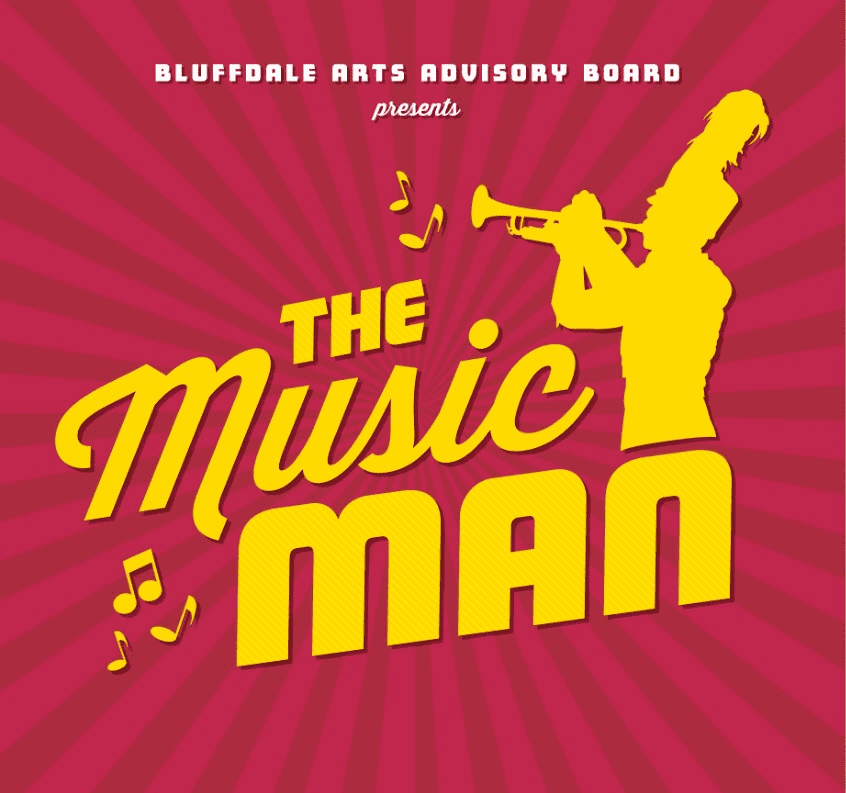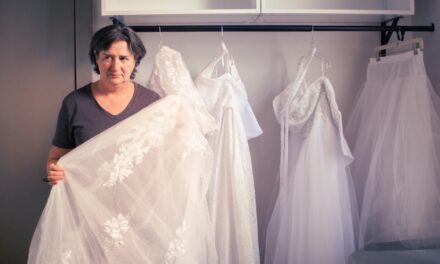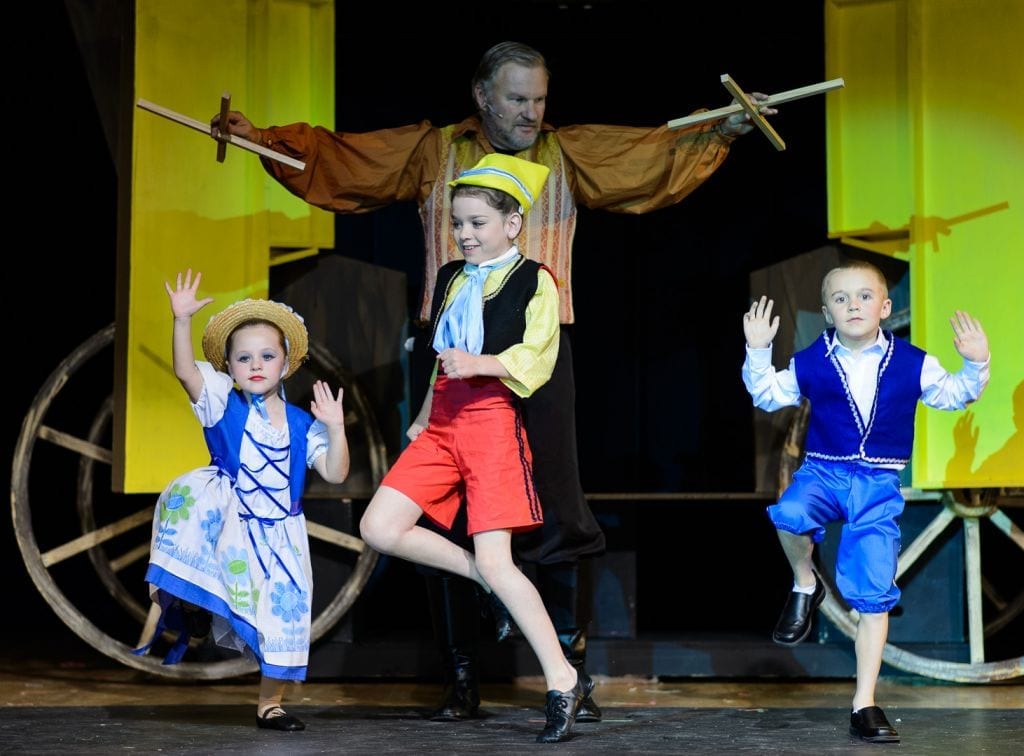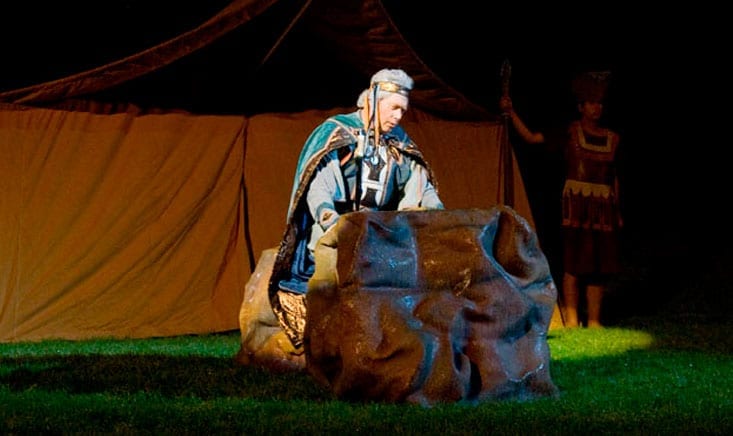BLUFFDALE – Meredith Willson’s The Music Man may hold the distinction of being the first musical I’ve ever seen on stage. While I still remember a lot of things from my original experience, I haven’t seen the show in over 20 years. So when I saw that the Bluffdale Arts Advisory Board was producing the musical, I jumped at the chance to review the show.
The show (directed by Laura Garner) follows the exploits of Harold Hill, a con artist played by Lucas Hammon, as he hoodwinks the town of River City, Iowa. What’s his pitch? He pretends to be a music instructor that will get troubled youth off the streets and into a band. Only a few characters have the ability to uncover his schemes. One such person is Marian Paroo, the town’s librarian and piano teacher. She was played by Hannah Hammon, a talented actress with a delightful soprano voice.
The cast is overwhelmingly large—there are over 180 cast members. When they all gathered on stage for the first time, I immediately realized that this show is intended to target families with young children. Unfortunately, I think they missed the mark. There was a surprisingly weak amount of energy coming from the stage, considering the impressive head count. Poor enunciation made it hard to understand some scenes. And lastly, forgotten lines and missed beats contributed to the show’s lengthy duration of more than 2 and a half hours.
I’m sorry to say that the most prominent offender was the actor playing Harold Hill himself. Hammon’s portrayal left out the attribute I’ve come to associate most with the character: charisma. During the song “Trouble,” in which he convinces the town that there’s, well, trouble in town, Harold Hill came off as a passive voice of conscience rather than a flashy evangelist. He may have caught the town of River City in his ruse, but I’m not convinced.
That’s not to say that the production was terrible. In fact, the next scene was a fresh juxtaposition that helped turn the production around. The next scene opened with Amaryllis (played on alternative nights by Emily Pehrson and Lily May Snow) playing a real piano. While I’m normally torn when actors play instruments on stage, this worked brilliantly. Mrs. Paroo (Dianne Evans) had a marvelous thick accent. And the argument between Mrs. Paroo and Marian was very comedic and executed perfectly.
In contrast to Hammon’s subdued energy, Russell Warne played a lively Marcellus Washburn. He showed the enthusiasm I was looking for. The difference between the two performances is most notable during their duet, “Sadder But Wiser Girl.” On one side of the stage, Hammon was cool and collected. On the other side, Warne demanded attention without overacting. For the sake of unity and continuity, Warne may have been better off toning it down. However, the show needed more oomph to engage the audience, and Warne’s delivery was refreshing.
The stars of the show, in my opinion, were the Paroo siblings. Winthrop Paroo (played by Daniel Schmidt) stepped up and delivered a well-rounded performance. His excitement was infectious during the Act I finale, “Wells Fargo Wagon.” I can’t wait to see Schmidt’s talent in future productions. But it was Hannah Hammon as Marian who stole the show. For me, it’s hard to believe her biography, which states that this is her “first time doing a big musical.” She is a natural performer.
The first thing I noticed when I walked into South Hills Middle School’s auditorium was the orchestra taking up a considerable amount of space in the house-right section of the room. There’s always danger in community theater when it comes to sound quality, and this was a potentially disastrous setup. However, the orchestra stayed well balanced under the direction of Cheryl Ann Blackley, and provided a perfect accompaniment to the musical.
Microphones and sound balance are never the strong point of any community production. As an audience member, I have no idea what technical difficulties may or may not be going on in the sound booth. Most of the show sounded pretty standard for the level of production, and I was able to focus on the excellent quality of singing. However, the sound was disappointing during the scenes involving the Ladies of River City. They provided some of the best comedy, and they sang very well, but only half of them had mics that worked. Whenever any of them without a mic had a line, their voices were covered up by those singing “pick a little…” in the background. Even on the second row I had no idea what they were saying.
The choreography (Vicki Wartman) had some obvious challenges, considering the size of the cast. When the full cast was on stage, choreography was limited to arm movements and other small movements, and sufficient at best. The notable dance numbers were “Marian the Librarian” and “Shipoopi.” There were a lot of trick steps in both numbers, which were fun to watch and probably difficult to perform. However, the steps didn’t really fit into the music or plot at all, and I’m confused why Wartman relied on them so much.
Given the size of the cast and subsequent size of the audience, I’m sure this production will be the first musical for many children, as it was for me years ago. While there are many things that could have made this more accessible to children, I think any kid who sees this version of The Music Man will enjoy it a lot. And at $6 a ticket, this show is probably worth it for adults as well.






